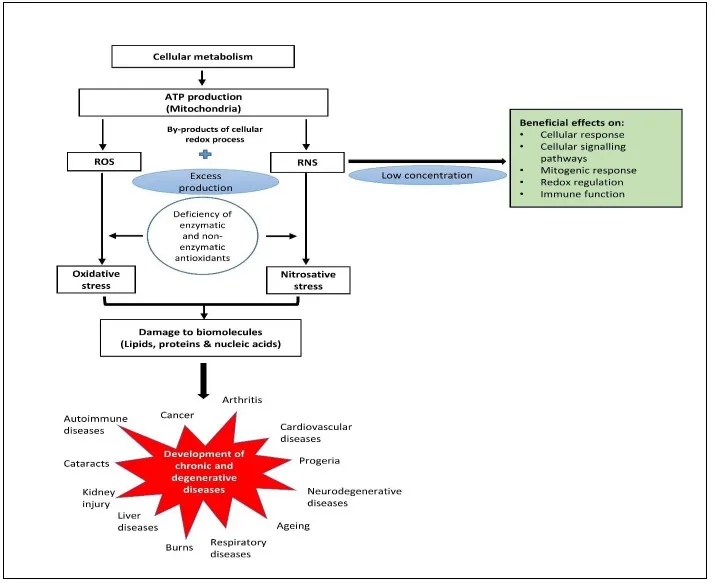Free Radical Biology of Diabetes Mellitus
Bidita Khandelwal1, *, Chamma Gupta2, Levin Thomas3, Sonal Sekhar Miraj3, Mahadev Rao3, Rubi Dey4, Karma Gurmey Dolma5, Rinchen Doma Bhutia2, Vijay Pratap Singh6 1 Department of Medicine, Sikkim Manipal Institute of Medical Sciences, Sikkim Manipal University, Gangtok, Sikkim-737102, India
2 Department of Biochemistry, Sikkim Manipal Institute of Medical Sciences, Sikkim Manipal University, Gangtok, Sikkim-737102, India
3 Department of Pharmacy Practice, Manipal College of Pharmaceutical Sciences, Manipal Academy of Higher Education, Manipal, Karnataka-576104, India
4 Department of Physiology, Sikkim Manipal Institute of Medical Sciences, Sikkim Manipal University, Gangtok, Sikkim-737102, India
5 Department of Microbiology, Sikkim Manipal Institute of Medical Sciences, Sikkim Manipal University, Gangtok, Sikkim-737102, India
6 Department of Physiotherapy, Kasturba Medical College, Manipal Academy of Higher Education, Manipal, 576104 India
Abstract
Free radicals play a pivotal role in the etiology of different diseases, including diabetes mellitus (DM). In the past three decades, the understanding of the fundamental role of free radicals in the etiology and disease progression of DM was studied broadly. This chapter aimed to enumerate the recent progress in the areas of free radical biology for the management of DM. Free radicals, as well as reactive oxygen species (ROS), having extra electrons in their outer orbitals, react with all biomolecules, including “protein, lipids, and DNA,” causing oxidative stress and damage. DM is also associated with oxidative stress induced by the elevated production of free radicals or reduced antioxidant activity. Recently, the importance of an antioxidant rich diet, yoga, and exercise has been well documented for the management of DM. Studies confirmed that exercise-induced ROS is an acute effect, while the chronic effect of exercise produces endogenous antioxidant defences and promotes a state of endogenous antioxidant defence mechanism. Therefore, regulating oxidative stress will lead to a significant future area of research for DM disease management.
Keywords: Antioxidant, Diabetes Mellitus, Oxidative damage, Oxidative stress, Reactive oxygen species.
* Corresponding author Bidita Khandelwal: Department of Medicine, Sikkim Manipal Institute of Medical Sciences, Sikkim Manipal University, Gangtok, Sikkim-737102, India; E-mail: [email protected] INTRODUCTION-FREE RADICALS
Free radicals have acquired a significant momentum in biology along with other oxidants because of their crucial functions in numerous physiological states and pathological implications in a wide range of disorders [1]. Chemical entities like atoms, molecules, and ions with one or more unpaired electrons in their outer orbitals, are referred to as free radicals, which generally display remarkable reactivities and also show independent existence ability [1, 2]. The odd number of electrons in free radical has been attributed to its instability, short-life, and higher reactivity [2]. These radicals have the ability to remove the electrons from another compound or biomolecules to become stable due to their greater reactivity. Thereby, the molecule undergoing an attack gives up an electron and is subsequently converted to a free radical. This process sets off a chain of reactions that causes injury or kills the cell which is alive [3].
Free radicals act as both harmful as well as valuable substances [4]. Therefore, they might be recognized as a necessary evil for signalling in the regular differentiation and migration process [5]. These species are generated during normal cellular metabolism or external sources such as radiation, pollution, smoking, etc. [4]. When cells utilize oxygen to produce energy, these species are released by the mitochondrial adenosine triphosphate (ATP) synthesis pathway. As a by-product of the cellular redox process, reactive nitrogen species (RNS), as well as reactive oxygen species (ROS), are released. The vital aspect of life is maintaining a subtle equilibrium between these two species’ antagonistic effects. An adequate quantity of RNS and ROS exerts favourable actions on different cellular responses, signalling pathways, mitogenic responses, redox regulation, and immune function [6, 7]. However, at high concentrations, both the species exert oxidative stress as well as nitrosative stress, producing potential deleterious effects on the biomolecules like lipids, proteins, nucleic acids, and others [8-13]. Overload of ROS/RNS, as well as a deficit of antioxidants (enzymatic as well as non-enzymatic), can produce oxidative and nitrosative stress. These stresses play a significant role in aging as well as developing chronic and degenerative disorders (Fig. 1). On the other hand, both endogenous and exogenous antioxidants serve as “free radical scavengers” and subsequently inhibit or repair injuries produced by free radicals [14-16].
Fig. (1)) Physiological and pathological role of free radicals in the biological system.
HISTORY ON THE CONCEPT OF FREE RADICALS IN BIOLOGICAL SYSTEM
The word ‘radical’ was first introduced in 1786 by French chemist Louis-Bernard Guyton de Morveau. Later, Gay-Lussac, Justus von Liebig, and Jöns Jakob Berzelius used the term to denote clusters of atoms that remained unaltered in several compounds. Early works involving free radicals were oxidative degradation of organic substances by hydrogen peroxide (H2O2) in the p...

